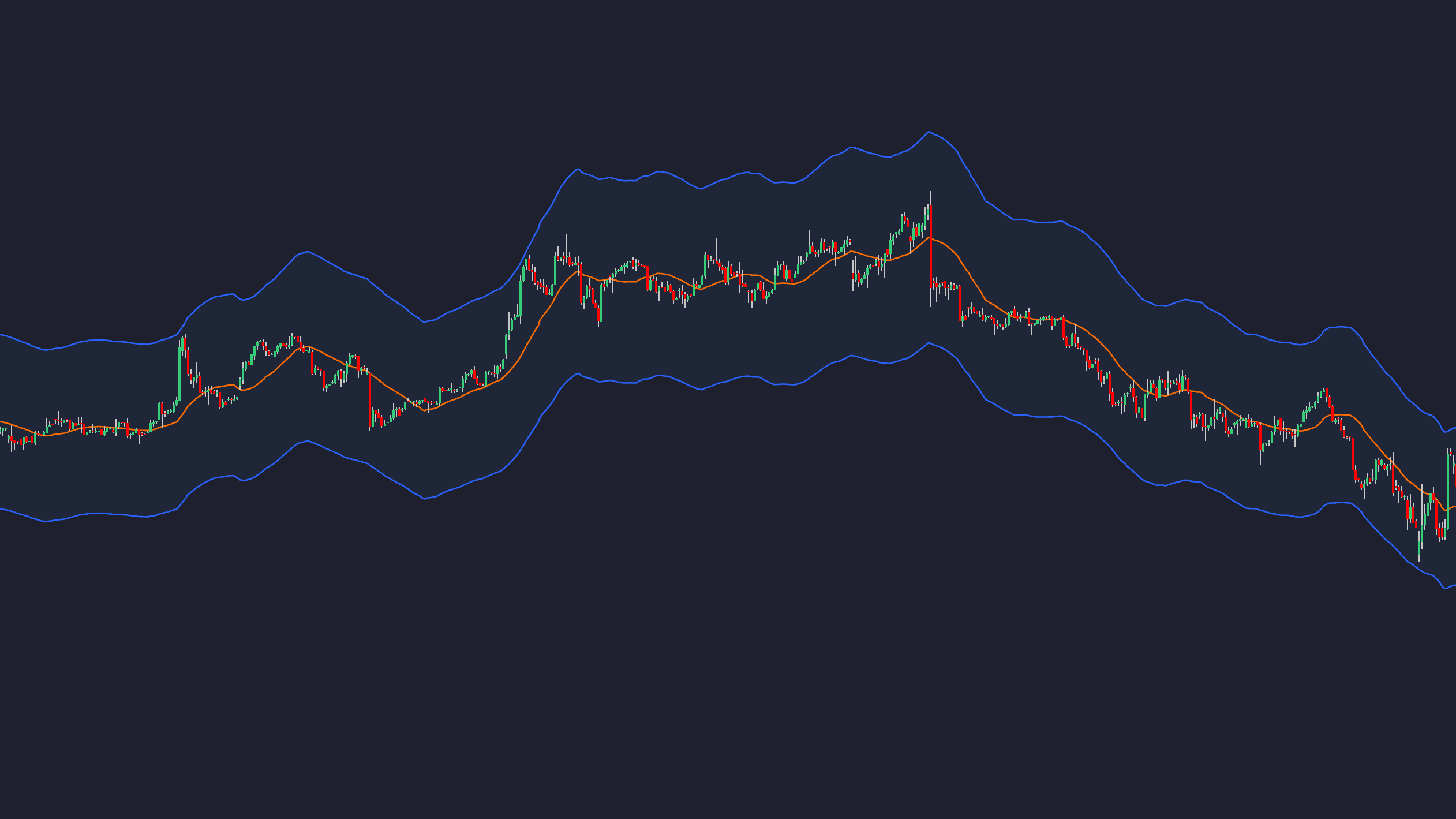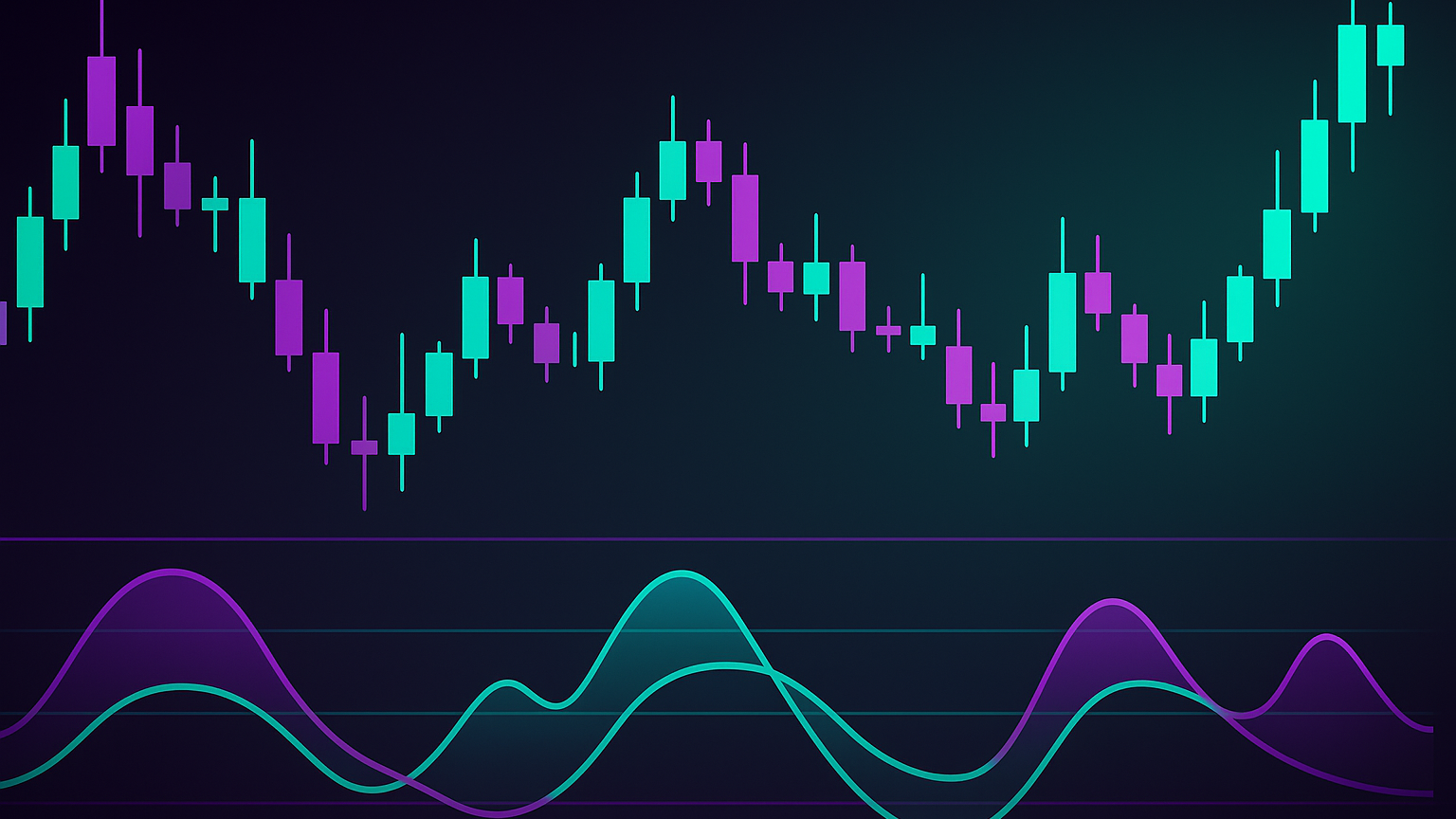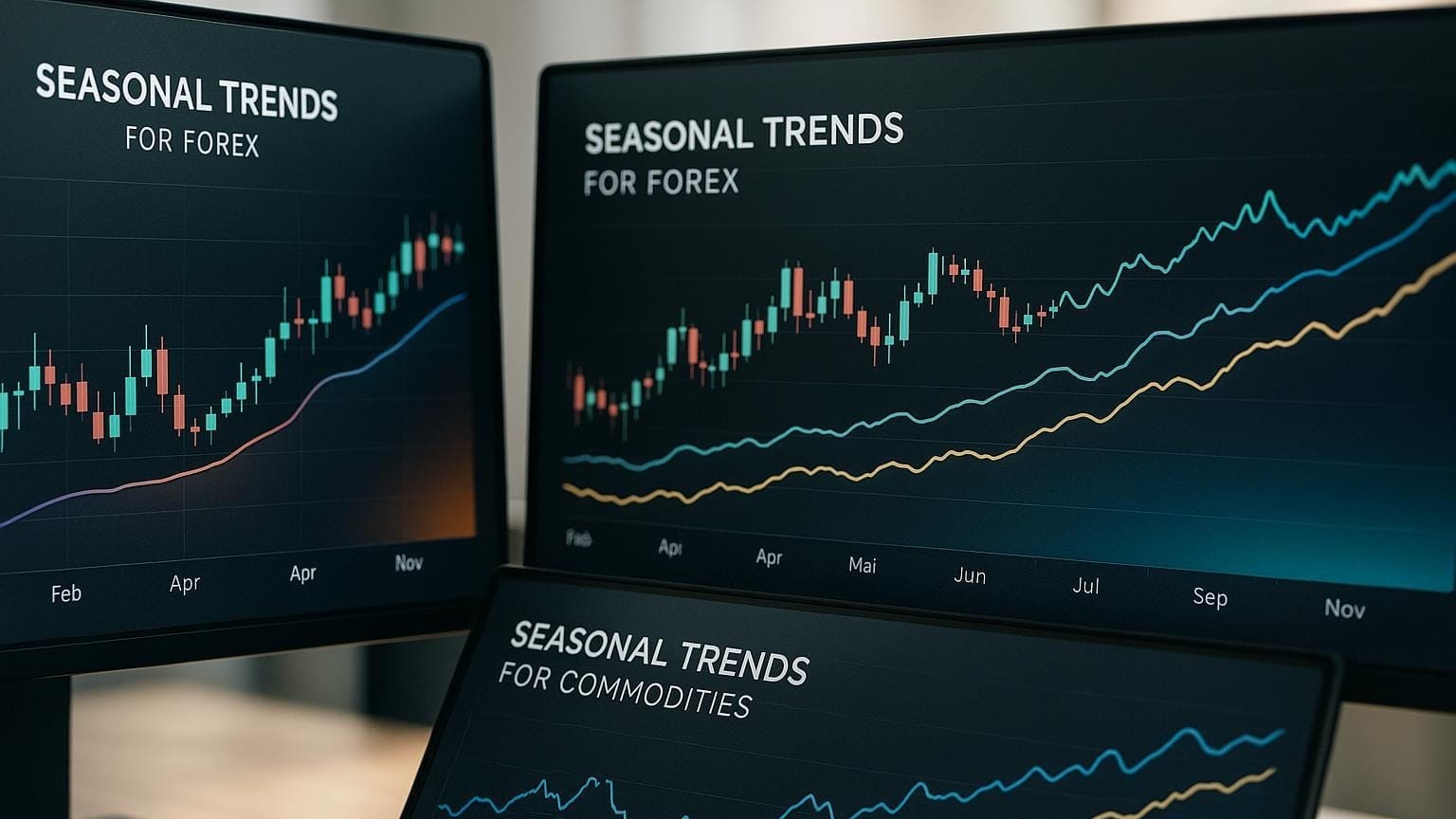Explore how the Envelope Indicator creates dynamic price bands for effective trading, enabling better decision-making in various market conditions.
The Envelope Indicator is a technical analysis method that creates dynamic price bands around a moving average. These bands, calculated as a percentage above and below the moving average, help traders identify overbought and oversold conditions, time trades, and set stop-loss or profit targets. It adjusts to market volatility, making it useful across different markets like stocks, crypto, and forex, and works on various timeframes.
Key points:
- How it works: Bands expand or contract based on volatility, signaling potential reversals or trend continuations.
- When to use: Effective for mean-reversion in range-bound markets and trend-following in directional markets.
- Customization: Adjust band width and moving average period to suit asset volatility and trading style.
- Limitations: Lagging signals, false alerts in sideways markets, and sensitivity to parameter settings.
Pairing it with tools like RSI, MACD, and volume indicators can refine its signals. Advanced models, such as ATR-based envelopes, offer better responsiveness to market conditions. Platforms like LuxAlgo provide TradingView-ready indicators, plus AI Backtesting and multi-tool integration for deeper analysis.
How Dynamic Bands Are Calculated

Band Calculation Formula
The Envelope Indicator uses a simple mathematical framework to define its dynamic bands. At its center is a moving average — commonly a Simple Moving Average (SMA) — which serves as the baseline. The upper and lower bands are positioned at a fixed percentage above and below this moving average.
Here’s how the calculations break down:
| Component | Formula | Description |
|---|---|---|
| Upper Band | Moving Average + (Moving Average × Percentage Deviation) |
Adds a set percentage to the moving average to define the upper band. |
| Lower Band | Moving Average - (Moving Average × Percentage Deviation) |
Subtracts a set percentage from the moving average to define the lower band. |
For example:
-
Using a 20-period SMA with a 10% deviation:
- Upper Band:
20-Period SMA + (20-Period SMA × 0.1) - Lower Band:
20-Period SMA - (20-Period SMA × 0.1)
- Upper Band:
-
With a 25-day SMA and a 3% deviation:
- Upper Band:
25-Day SMA + (25-Day SMA × 0.03) - Lower Band:
25-Day SMA - (25-Day SMA × 0.03)
- Upper Band:
This percentage-based method ensures the bands maintain a consistent distance from the moving average, regardless of the asset's price level.
Key Parameters Explained
Two main settings influence how the Envelope Indicator behaves: the averaging period (N) and the deviation value (K or D).
- Averaging Period: This determines how many price bars are used to calculate the moving average. Shorter periods (e.g., 10 or 15) make the bands more responsive to price changes, which is ideal for day traders seeking quick signals. On the other hand, longer periods (e.g., 50 or 100) result in smoother bands, filtering out short-term price noise — something swing traders often prefer.
- Deviation Value: This controls the distance between the bands and the moving average. Smaller deviations (e.g., 2% or 3%) create tighter bands that interact with price more frequently, generating more signals. Larger deviations (e.g., 8% to 12%) result in wider bands, producing fewer but potentially more reliable signals.
Volatility is a critical factor when setting these parameters. For highly volatile assets, such as cryptocurrencies or growth stocks, larger deviations help reduce false signals. Low-volatility instruments, like utility stocks or government bonds, typically perform better with smaller deviations.
These adjustable parameters allow traders to fine-tune the indicator based on their strategy, timeframe, and the specific characteristics of the asset being analyzed.
How Bands Adjust to Market Volatility

The Envelope Indicator’s unique feature is its ability to maintain a fixed percentage distance from the moving average, which influences how it responds to market volatility.
As an asset’s price rises, the bands adjust proportionally. For instance, if a stock moves from $50 to $100, a 5% deviation band that was $2.50 wide would expand to $5.00 wide, keeping the same percentage distance. This proportional adjustment ensures the indicator remains relevant across varying price levels.
In trending markets, this characteristic shines. As prices move in one direction, the bands follow the trend while preserving their proportional spacing. This helps traders differentiate between routine price movements within a trend and signals of potential reversals.
However, this fixed-percentage approach does require manual adjustments when volatility shifts significantly. For example:
- During high-volatility periods, increasing the deviation percentage widens the bands, reducing the risk of false signals.
- In calmer markets, smaller deviations create tighter bands, making it easier to capture subtle price movements.
These manual tweaks demand active monitoring of market conditions to ensure the bands remain aligned with current volatility levels.
Reading Envelope Indicator Signals
Overbought and Oversold Conditions
When the price touches or moves beyond the upper band, it often indicates overbought conditions, suggesting the asset could pull back soon. On the flip side, breaking below the lower band points to oversold conditions, hinting at a potential rebound.
The strength of these signals depends on how the price interacts with the bands. A quick touch followed by a retreat might confirm overbought or oversold conditions. However, if the price pushes through a band and continues in the same direction, it could signal a stronger trend rather than an imminent reversal.
How the price behaves around the bands adds more context. For instance, if the price lingers near the upper band during a trending market, it may reflect ongoing strength rather than exhaustion. Sustained moves along the bands generally carry more weight than brief touches.
Trend-Following vs. Mean-Reversion Strategies
Traders interpret envelope signals differently depending on their strategy. Mean-reversion traders see band touches as opportunities for reversals, expecting the price to move back toward the moving average. They typically sell when the price hits the upper band and buy when it touches the lower band. For background on the concept, see mean reversion in finance.
On the other hand, trend-following traders view band breakouts as signs of continuation. A breakout above the upper band in an uptrend signals a chance to add to long positions, while a break below the lower band in a downtrend offers an opportunity to increase short positions.
Mean-reversion strategies work best in ranging markets, where the price oscillates between support and resistance. Here, the bands act as dynamic support and resistance, creating predictable bounce points. For a primer, see a concise overview of range-bound trading.
Trend-following strategies excel in directional markets, where a strong trend causes the price to hug one band as the envelope shifts in the trend's direction. Instead of betting against the trend, trend-followers use band interactions to time their entries in line with the prevailing momentum.
Many successful traders combine these approaches by first assessing the broader market context. In trending markets, they lean toward trend-following signals. During consolidation phases, mean-reversion signals become more effective. Adjusting strategies to suit the market environment is key.
Trading Different Market Conditions
Envelope Indicator signals must always be interpreted within the broader market context. In trending markets, the price often clings to the upper band during strong uptrends, which can generate misleading overbought signals for mean-reversion strategies. In these cases, focusing on the middle line (the moving average) as dynamic support is more effective. Pullbacks to the middle line or touches on the lower band often present good buying opportunities within an uptrend.
The most reliable signals in trending markets occur when the price temporarily pulls back to the moving average or nears the opposite band. These corrections often provide favorable entry points for trend-following strategies.
In ranging markets, the Envelope Indicator truly shines. The price typically moves predictably between the upper and lower bands, making overbought and oversold conditions easier to identify. During these periods, reversal signals are more reliable, as the price remains confined within a horizontal range. A good general guide to ranges can be found here: what is a range-bound market?
Traders in range-bound markets can often establish a rhythm: buying near the lower band and selling near the upper band. The moving average acts as a neutral zone, helping traders judge whether the current move toward a band has enough momentum.
Volatile markets require tighter parameter adjustments to maintain the quality of signals. High volatility can lead to frequent false breakouts above or below the bands, causing whipsaw trades. Adjusting the envelope's parameters helps filter out noise and avoid unnecessary losses.
In contrast, low-volatility markets present a different challenge. Here, narrow price movements may rarely reach the bands, especially if the deviation percentage is too wide. Tightening the bands in these conditions can ensure signals remain relevant to the actual price action.
Finally, the timeframe plays a big role in how signals are interpreted. On shorter timeframes, such as 5-minute or 15-minute charts, band touches happen more often but tend to be less reliable. Longer timeframes, like daily or weekly charts, generate fewer signals but with stronger conviction, making them ideal for traders aiming for longer-term positions.
Trading Strategies with the Envelope Indicator
Common Trading Strategies
Using the insights provided by envelope signals, traders can refine their strategies to improve the timing of entries and exits.
In range-bound markets, the band bounce strategy is a popular choice. Here, traders buy when the price hits the lower band and sell at the upper band, using the moving average as a potential profit-taking zone. This approach works best when confirmed by volume — higher trading volume during band bounces often signals stronger reversals.
For those looking to trade breakouts, breakout confirmation is key. A sustained move beyond the upper envelope band, especially on strong volume, typically signals the start of an uptrend. Conversely, a breakdown below the lower band suggests downward momentum. To reduce false signals, traders should wait for a full candle close beyond the band before entering a position.
In trending markets, trend-following entries focus on pullbacks to the moving average. For example, during an uptrend, a pullback toward the moving average offers a better entry price while maintaining alignment with the overall trend.
When it comes to risk management, stop-loss placement is streamlined with envelope bands. Traders often place stop-loss orders just beyond the opposite band of their entry. For instance, if entering a long position near the lower band, the stop-loss would be set slightly below that band. This approach helps define risk while accounting for normal price fluctuations.
Profit targets can also be aligned with the envelope structure. Conservative traders may exit when the price reaches the opposite band, while others might hold until price action shows rejection at the bands. Some traders take partial profits at the moving average and let the remainder ride for a band-to-band move.
Combining with Other Indicators
Pairing the envelope indicator with other tools can improve the quality of trading signals.
- Volume indicators are particularly useful. For example, when the price touches the lower band on high volume, it often signals genuine selling pressure and a potential reversal. The On-Balance Volume (OBV) indicator is a good complement, as divergences between OBV and price near envelope extremes can highlight upcoming reversals.
- RSI (Relative Strength Index) adds an additional layer of confirmation. If the price hits the upper band while RSI is above 70 (overbought), it reinforces a potential reversal. Similarly, lower band touches combined with RSI readings below 30 (oversold) often mark buying opportunities, reducing the likelihood of false signals.
- MACD crossovers near envelope bands can provide precise timing. A bullish MACD crossover occurring as the price bounces off the lower band strengthens the case for a reversal. This combination is particularly effective on daily charts, where patterns tend to be more reliable.
- Bollinger Bands, when used alongside envelopes, create a dual-band system. If both indicators show the price touching their respective upper or lower bands simultaneously, it strengthens the reliability of the signal.
- Moving average convergence offers another layer of analysis. When the price approaches an envelope band and a key moving average (like the 200-day moving average) at the same time, it creates a high-probability trade setup.
These combinations make envelope-based strategies more dynamic and adaptable.
Advanced Envelope Models
For traders seeking more precision, advanced envelope models offer refined approaches.
- ATR-based envelopes adjust dynamically to market volatility. Instead of using fixed percentage bands, these envelopes rely on the Average True Range (ATR) to determine band distances. During periods of high volatility, the bands widen to account for larger price swings, while they contract in calmer markets. Traders often use multipliers (e.g., 1.5 to 3.0 times the ATR) to set band widths — higher multipliers suit swing trading, while lower ones are better for day trading.
- Quadratic kernel envelopes apply mathematical smoothing techniques like kernel regression to create smoother and more responsive bands. Unlike traditional envelopes, these models are better at anticipating trend changes, making them ideal for noisy markets or shorter timeframes where false signals can be a problem.
- Adaptive envelopes take things a step further by adjusting in real-time based on market conditions. These models analyze factors like volatility and trend strength to optimize band positioning. For instance, in a trending market, the envelopes might shift their center point or widen the bands to better capture momentum. Some adaptive systems even incorporate machine learning algorithms to learn from historical price patterns and refine their performance over time.
- Multi-timeframe envelope systems combine signals from different chart periods to enhance decision-making. For example, a trader might use weekly envelopes to determine the broader trend, daily envelopes for identifying entry points, and hourly envelopes for precise execution. This layered approach helps filter out conflicting signals and provides a clearer picture for swing traders balancing long-term positioning with short-term tactics.
These advanced approaches provide traders with tools to navigate a variety of market conditions while maintaining clear risk and reward parameters.
Envelope Indicator on TradingView

Pros and Cons of the Envelope Indicator
Having explored various trading strategies, it’s important to weigh the strengths and weaknesses of the Envelope Indicator. This insight can help traders decide when and how to use it effectively.
Main Benefits
The Envelope Indicator brings several advantages to the table, making it a versatile method for traders with different levels of experience and trading preferences.
One of its biggest strengths is its simplicity and visual clarity. Unlike more intricate indicators, envelope bands provide a straightforward visual representation of price boundaries. This makes it easier for traders to spot key price movements without needing to decode complex data. The visual cues near the bands are clear and often more noticeable than subtle shifts in oscillators or intricate indicator setups.
Another major plus is its broad applicability across various market conditions. Whether the market is trending, moving sideways, or experiencing volatility, the envelope bands adjust to provide relevant insights. This adaptability can reduce the need to juggle multiple indicators as conditions shift.
The indicator is also highly effective at defining risk parameters. The bands naturally suggest logical stop-loss levels and profit targets, which can take much of the guesswork out of trade execution and position sizing.
Additionally, the Envelope Indicator offers multi-timeframe compatibility, making it suitable for short-term, medium-term, or long-term trading. This consistency means traders can apply the same principles regardless of their preferred time horizon.
Common Limitations
While the Envelope Indicator has its strengths, it’s equally important to understand its limitations.
One key drawback is its lagging nature. Since the bands are usually based on moving averages, they react to past price movements rather than forecasting future ones. This can lead to delayed signals during rapid market shifts, potentially causing traders to miss ideal entry or exit points.
The indicator also struggles in choppy or sideways markets, where it may produce multiple buy and sell signals as prices hover around the bands without a clear direction. These false signals can lead to frustrating losses if not properly managed.
Sensitivity to parameter settings is another challenge. The width of the bands, determined by a percentage or ATR multiplier, can greatly influence the frequency and accuracy of signals. Narrow bands may trigger too many false positives, while wider bands could miss short-term opportunities. Striking the right balance requires thorough testing and adjustments tailored to specific markets.
Additionally, the Envelope Indicator shows limited effectiveness during strong trends. When markets are in a powerful uptrend or downtrend, prices might hover near one band for an extended period. This can render mean-reversion strategies ineffective, leaving traders fighting the trend instead of riding it.
Finally, the indicator is vulnerable to sudden gaps and news-driven price movements. Sharp price jumps that bypass the bands can expose traders to unexpected losses, especially if they rely on tight stop-loss levels based on the bands. Adjusting parameters, as discussed earlier, can help reduce this risk.
Comparison Table: Pros and Cons
Here’s a quick overview of the Envelope Indicator’s strengths and weaknesses:
| Advantages | Disadvantages |
|---|---|
| Easy to understand and interpret visually | Lagging signals during fast market moves |
| Works across different timeframes | Generates false signals in sideways markets |
| Defines clear risk management levels | Sensitive to parameter adjustments |
| Adapts to various market conditions | Limited in strong trending markets |
| Suitable for multiple trading styles | Vulnerable to gaps and price shocks |
| Helps identify overbought/oversold zones | May miss short-term opportunities |
| Combines well with other tools | Requires additional confirmation |
| Accessible for beginners and pros alike | Can lead to whipsaw trades |
Using LuxAlgo with Envelope Indicator Analysis

The Envelope Indicator is useful for identifying price boundaries, but its potential grows significantly when paired with LuxAlgo’s TradingView-ready indicators. LuxAlgo provides exclusive toolkits that address common weaknesses and enhance strengths, creating a more effective system for trading decisions. Let’s dive into how these toolkits elevate envelope analysis.
LuxAlgo Toolkits for Better Analysis
LuxAlgo offers three powerful toolkits that work seamlessly with envelope bands, providing deeper insights and more reliable signals.
The Price Action Concepts (PAC) toolkit helps identify critical market structures that align with envelope signals. For example, when price nears the upper or lower envelope bands, PAC’s auto-pattern detection highlights whether this movement corresponds with key support or resistance levels. Additionally, the toolkit’s volumetric order blocks offer insights into institutional activity near these boundaries.
Imagine price hitting the upper envelope band: PAC’s analysis can confirm whether this aligns with a significant resistance level or an order block, giving you the confidence to act — or avoid a potential trap — in volatile markets.
The Signals & Overlays (S&O) toolkit adds another layer of validation. It uses multiple signal algorithms and overlays to confirm whether market sentiment supports a reversal or continuation when price interacts with the envelope bands. What’s more, the toolkit is customizable, allowing you to adjust signal sensitivity to align with your envelope settings, creating a cohesive and tailored trading strategy.
The Oscillator Matrix (OSC) toolkit addresses a common challenge with envelope indicators: spotting momentum shifts. By detecting real-time divergences, OSC identifies when price action near the envelope bands doesn't match momentum. This early warning system helps traders avoid false breakouts or missed reversals, offering a level of precision that envelopes alone cannot provide. Learn more about LuxAlgo’s oscillator features here.
AI Backtesting for Strategy Optimization
LuxAlgo takes envelope strategies to the next level with its AI Backtesting Assistant, simplifying the process of optimizing parameters for different market conditions. Instead of manually tweaking percentage bands or ATR multipliers, this platform uses data-driven backtesting to evaluate thousands of configurations across various timeframes and assets.
What sets it apart is its deep optimization engine, which goes beyond basic parameter adjustments. By combining envelope signals with other LuxAlgo tools, the system uncovers multi-layered strategies. For instance, it might reveal that envelope reversals are most effective when confirmed by OSC divergences and PAC support levels, along with specific parameter settings that enhance win rates and reduce drawdowns. Read more: recent AI Backtesting updates and the Backtesting Assistant docs.
Platform Integration and Support
LuxAlgo’s integration with TradingView ensures that envelope analysis fits seamlessly into your workflow. You can apply envelope indicators alongside LuxAlgo’s tools in real time. The Custom Alert Creator is particularly useful here: set alerts that trigger only when specific conditions are met, such as price touching the envelope bands and meeting other LuxAlgo criteria.
LuxAlgo also supports traders with live assistance and an active user community. Weekly scanners and educational content help surface assets where envelope setups — combined with other technical factors — are forming across markets and timeframes.
Conclusion
The Envelope Indicator offers a straightforward yet powerful way to spot reversals and follow trends across various market conditions.
Key Takeaways
What makes this method stand out is its simplicity. Unlike more intricate oscillators that demand a deep dive into technical analysis, envelope bands provide an easy-to-understand method for identifying when prices might be stretched too far.
If you're using mean-reversion strategies, the outer bands work well in ranging markets, signaling potential turning points. For trend-following strategies, breakouts beyond the envelope boundaries can highlight opportunities to ride the trend. However, success depends on pairing the indicator with the right market context and solid risk management.
That said, the Envelope Indicator isn't perfect. It can lag or give false signals during sudden market shifts. For a more reliable approach, combine it with other methods that complement its strengths and fill in its gaps.
Getting Better Results with LuxAlgo
LuxAlgo enhances envelope analysis by addressing common weaknesses and expanding capabilities. With its TradingView-ready indicators and AI Backtesting, LuxAlgo helps transform envelopes into a more comprehensive trading workflow.
- The Price Action Concepts toolkit adds a layer of market structure analysis, helping you see if envelope signals align with key support and resistance.
- The Signals & Overlays toolkit offers additional confirmation layers, reducing the risk of acting on false breakouts. Explore it on the indicator page.
- The Oscillator Matrix toolkit tackles momentum divergences near envelope bands. See LuxAlgo’s oscillator overview here.
For even deeper insights, the AI Backtesting Assistant can analyze thousands of configurations. This helps you find the best envelope settings for your assets and timeframes while uncovering ways to combine envelope signals with other tools for stronger strategies.
With TradingView integration and the Custom Alert Creator, you can stay updated on high-probability setups without being glued to your screen.
FAQs
How can traders adjust the Envelope Indicator to suit different markets and assets?
To get the most out of the Envelope Indicator, traders need to tweak two main settings: the moving average period and the bandwidth percentage. In markets with high volatility, a larger bandwidth can help screen out misleading signals, while a smaller bandwidth is better for steady markets, offering more precise insights.
The moving average period should also align with the asset's behavior. For markets with strong trends, longer periods are useful for capturing the broader direction. On the other hand, shorter periods are ideal for range-bound markets, as they emphasize quicker price shifts. Adjusting these settings allows traders to tailor the indicator to various market scenarios and asset types, making it more effective for technical analysis.
How can I effectively combine the Envelope Indicator with RSI and MACD for better trading decisions?
To use the Envelope Indicator alongside RSI and MACD effectively, start by leveraging the Envelope to spot possible overbought or oversold conditions. Watch for price movements that break outside the Envelope bands, as these could indicate a potential reversal.
Then, check the RSI to confirm these signals. Look for RSI readings near the extremes — values above 70 suggest an overbought condition, while those below 30 point to oversold levels. Finally, turn to the MACD to evaluate trend reversals or shifts in momentum. Pay attention to MACD crossovers or divergences, as these can help validate your decision to enter or exit a trade.
When you combine these tools, you can filter out false signals and enhance the precision of your trades, creating a more reliable and well-rounded strategy.
How does LuxAlgo improve the Envelope Indicator for more precise trading insights?
LuxAlgo enhances Envelope-based analysis by adding features designed to improve usefulness for traders. One standout capability is the ability to create real-time alerts that notify you whenever prices break through the envelope boundaries using the Custom Alert Creator. This helps you identify potential overbought or oversold conditions as they happen.
Another key addition is the ability to customize toolkit settings. You can adjust parameters to better align with current market trends, which can help minimize false signals and make your analysis more accurate.
References
LuxAlgo Resources
- Nadaraya–Watson Envelope — Indicator
- Moving Average Converging — Indicator
- Take Profit & Stop Loss (S&O Backtester)
- How to Trade Reversals using LuxAlgo Tools
- Trending Market Toolkit — Indicator
- AI Backtesting Assistant
- New AI Backtesting Features for Smarter Trading
- Backtesting Assistant — Docs
- PAC: Market Structures — Docs
- PAC: Volumetric Order Blocks — Docs
- Market Sentiment Technicals — Indicator
- Volume Forecasting — Indicator
- Liquidation Levels — Indicator
- LuxAlgo Algos (Toolkits Overview)
- LuxAlgo — Home








